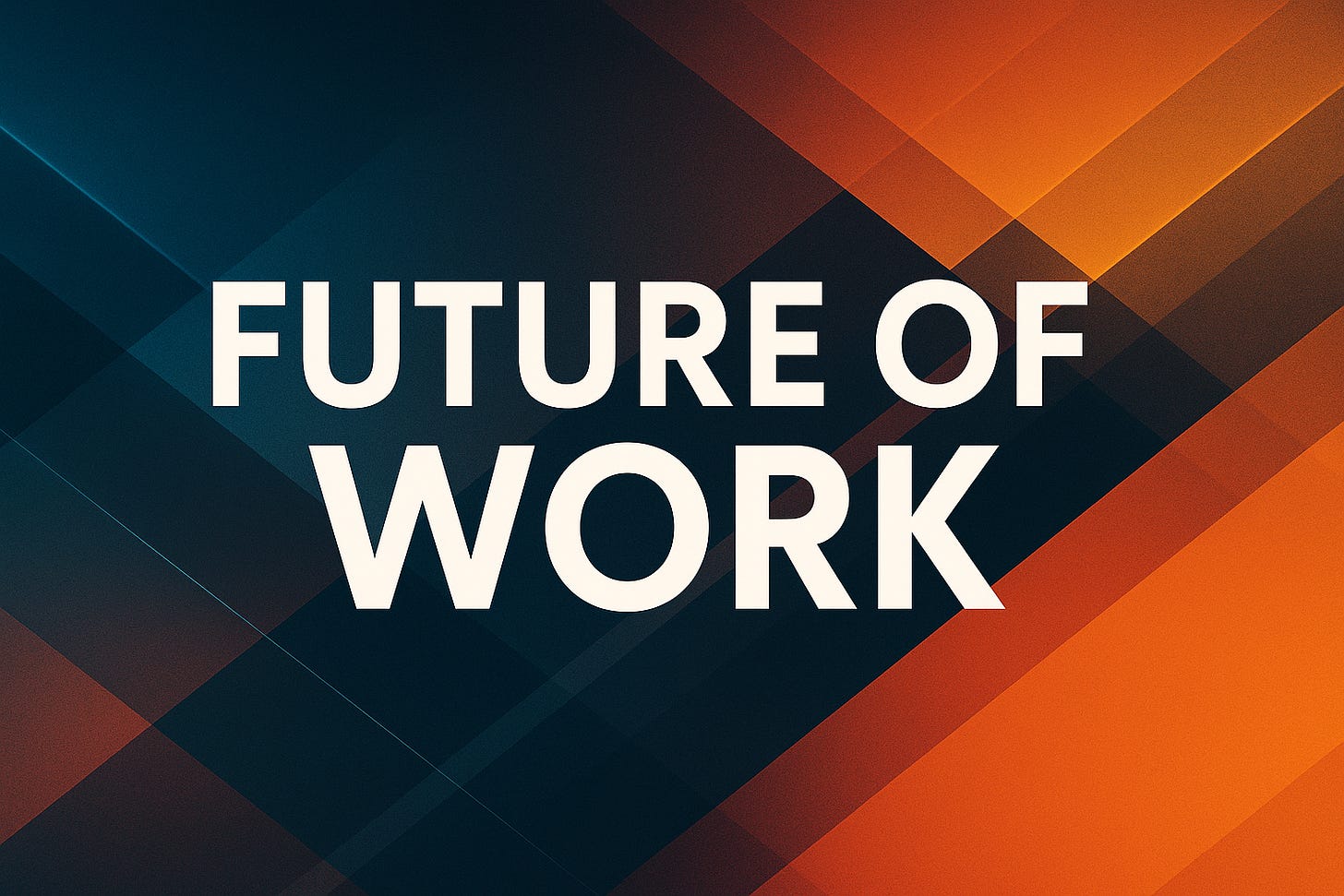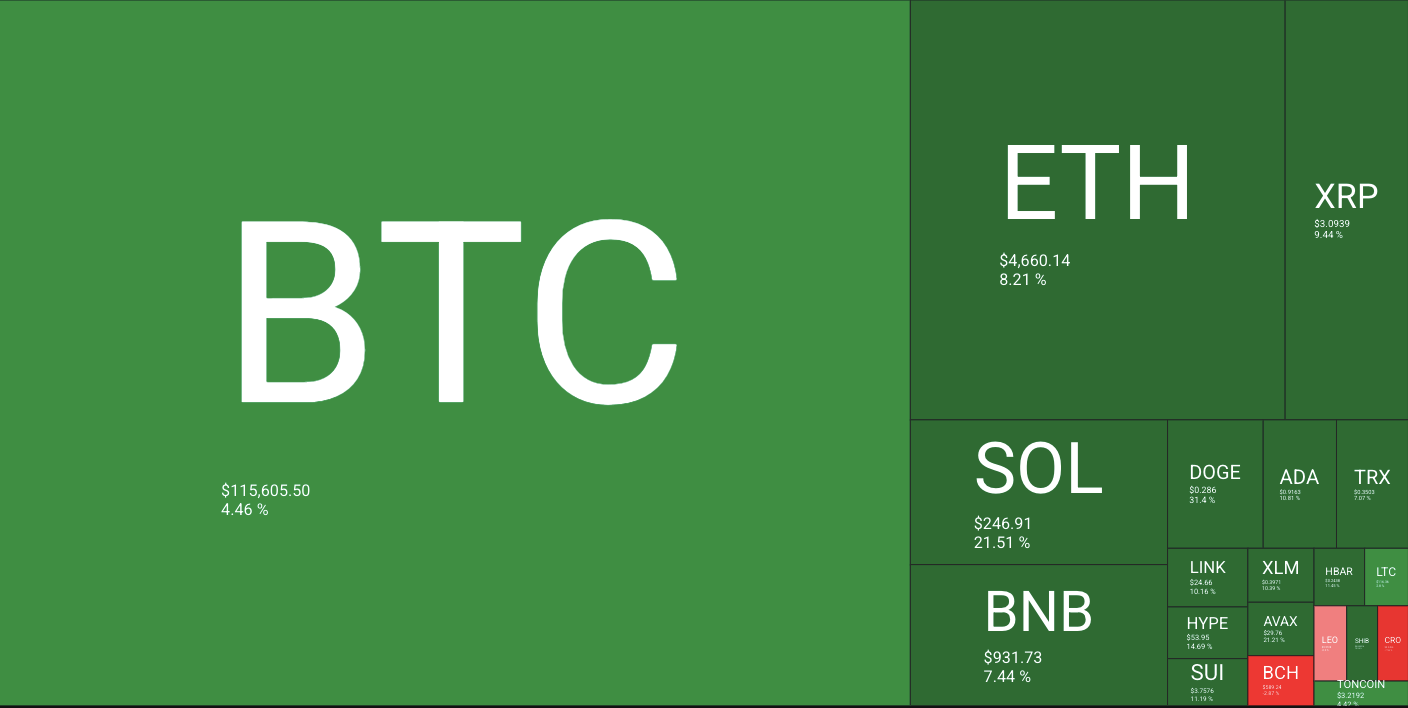Weekly Journal Special Edition: The Future of Work
[6 min read] Your weekend guide to getting ahead on the digital frontier. This week we are reimagining work at the intersection of technology, flexibility, and human creativity.
Welcome to this week’s Weekly Journal 📔, your guide to the latest news & innovation in emerging technology, digital assets, and our exciting path to the Metaverse. This is week 145 of the 520 weeks of newsletters I have committed to, a decade of documenting our physical and digital lives converge. New subscribers are encouraged to check out the history & purpose of this newsletter as well as the archive.
- Ryan
🌐 Digital Assets Market Update
To me, the Metaverse is the convergence of physical & virtual lives. As we work, play and socialise in virtual worlds, we need virtual currencies & assets. These have now reached mainstream finance as a defined asset class:
🔥🗺️Heat map shows the 7 day change in price (red down, green up) and block size is market cap.
🎭 Crypto Fear and Greed Index is an insight into the underlying psychological forces that drive the market’s volatility. Sentiment reveals itself across various channels—from social media activity to Google search trends—and when analysed alongside market data, these signals provide meaningful insight into the prevailing investment climate. The Fear & Greed Index aggregates these inputs, assigning weighted value to each, and distils them into a single, unified score.
🗞️ Metaverse news from this week:
Sinéad Bovell: The future of work = independent.
“We are moving towards a new workforce fabric that will skew heavily towards independent work and entrepreneurship. Instead of thinking about yourself in terms of the job that you do think of yourself as a mini organization that offers a bundle of skills that can be applied across various companies and projects. It’s a mindset shift for sure.
There are a few job-negotiable skills for this future (shared at the end of the video).
There are many implications of workforce that is grounded in independent work, from healthcare to security, which I write about in my Substack.”
Another excellent piece from Sinéad that hit home as a father of a child about to start school:
Portable benefits, hybrid worker models, and the metaverse economy converge
The long-standing binary of “employee vs. contractor” is fracturing. With new momentum behind portable benefits and experiments like California’s Proposition 22, a third model of work is emerging—one that preserves independence while providing baseline protections. The shift is more than a labour issue; it’s a business imperative. Companies want to support gig and freelance workers with healthcare, retirement savings, or insurance, but current law often penalises them for doing so. This leaves independent workers without safety nets and businesses paralysed by risk.
From a metaverse perspective, the stakes are even higher. The metaverse economy thrives on fluid, project-based collaboration—from creators building virtual worlds to developers running decentralised apps. If benefits remain tied to traditional employment, vast swathes of digital labour will remain unsupported and exposed. The metaverse demands portable, identity-linked benefits that follow the worker across platforms, gigs, and even jurisdictions. Just as digital assets and avatars can persist across virtual worlds, so too should protections and rights persist across different forms of work.
With US legislators, states, and private companies exploring hybrid models, we may be reaching a tipping point. Whether regulators embrace this third way will determine if the future of work—and the metaverse economy—evolves as inclusive, innovative, and resilient, or remains shackled to outdated industrial-era systems.
Marc Andreessen on Using Blockchain to Battle Deepfakes
Deepfakes are a real problem and getting worse, and it impacts companies as much as anyone. There are multiple cases of Deepfakes tricking employees into paying false payment, thinking their CEO just instructed them.
At recent a16z LP Summit for 2025, Marc Andreessen offered a solution to deepfakes that sounds like something out of science fiction. He argues that trying to “check for fakes” is a dead end-we’re already seeing AIs fail and falsely accuse people. His alternative is to flip the entire problem on its head. Create a system to verify what’s authentic from the start using a blockchain, a kind of permanent, verifiable record of reality. It’s a fundamental shift from hunting fakes to proving what’s real.
📖 Read of the week: "AI Will Devastate the Future of Work. But Only If We Let It"
🗞 By Gary Rivlin | TIME Ideas | August 2025
Gary Rivlin paints a vivid picture of AI’s disruptive potential—calling it an economic earthquake with the power to reshape nearly every job sector. From call centres and junior developers to drivers and creatives, the early signs of displacement are already visible. Yet the article also makes clear: the outcome isn’t inevitable.
Key takeaways:
⚡ AI’s unique challenge: Unlike past technologies, which automated physical tasks, AI automates reasoning and creativity, touching almost every white- and pink-collar field.
📉 Early disruption is real: Voice actors, illustrators, and coders are already seeing reduced opportunities as AI tools prove cheaper and faster.
🚕 Broader risks loom: Millions of driving and warehouse jobs may be next as autonomous vehicles and robotics scale.
🌱 But opportunity exists: Smart leaders see AI as a force multiplier—freeing up humans to create new services, products, and innovations that weren’t possible before.
🧭 The human choice: With better policy, strong worker engagement, and responsible adoption, AI could augment human potential rather than replace it.
Rivlin’s message isn’t one of doom but of urgency: the future of work will be what we make it. If we choose wisely, AI can create more fulfilling roles, widely shared prosperity, and new industries—just as past technological shifts eventually did.
🎥 Watch of the week: How artificial intelligence will impact the workforce: what workers need to know
New report from the IMF on the impact of AI on the workforce shows 40% of jobs are exposed to AI. However, exposure does not mean automation. Sinead joins NBC News to discuss what that means for workers and what countries, companies and individuals should be doing to prepare
AI Spotlight 🎨🤖🎵✍🏼: AI and the Future of Work: Yang’s Warnings vs. Labor’s Optimism.
In the Metaverse, AI will be critical for creating intelligent virtual environments and avatars that can understand and respond to users with human-like cognition and natural interactions.
At the recent Ai4 conference in Las Vegas, two visions of AI’s impact on work collided.
Andrew Yang warned of an AI-driven “tidal wave” of layoffs already rippling through retail, call centres, and even white-collar jobs once thought safe. His solution? Universal Basic Income and direct support to families — because without a link between effort and reward, he argues, motivation and social trust erode fast.
On the other side, Taylor Stockton of the U.S. Department of Labor painted a more optimistic picture: AI as a net job creator, much like past tech revolutions. He sees opportunities in apprenticeships, AI literacy, and alternative training pathways that bypass the failing “college for all” model. The U.S. government’s new “AI Action Plan” backs that vision with infrastructure, sandboxes, and global AI diplomacy.
From a metaverse perspective, this debate is pivotal. As immersive worlds and AI agents start to blur the boundaries between human and machine labour, Yang’s fears of displacement clash with Stockton’s view of augmentation. The metaverse could become a testing ground: will it be filled with AI-powered workers replacing humans, or a hybrid economy where human creativity and AI augmentation open new job frontiers?
Either way, the stakes are clear: the future of work won’t just play out in offices and factories, but in the digital worlds we’re already building.
That’s all for this week! If you have any organisations in mind that could benefit from keynotes about emerging technology, be sure to reach out. Public speaking is one of many services I offer.




